Introduction
Previously, I discussed the camouflage schemes and patterns the Wehrmacht utilized with its ground vehicles, and provided imagery to support the information I provided. This time around, we’ll be discussing the tactical markings (and some non-tactical ones) that could commonly be found on German armored vehicles throughout the war.
I’d like to again clearly state my presentations are strictly apolitical and not partisan. I do not favor, support, advocate, or promote in anyway, any particular political, socioeconomic, or national agenda and it is my sincerest hope that those who read this article will appreciate that as I proceed. This is strictly for demonstrating historical significance and information. To start with, I’ll be covering the tactical markings and camouflage for German vehicles, though like other nations, to really cover every, single little detail, variation, or controversy would require an extremely large tome and more exhaustive research than I currently have the ability to perform (not to rule it out in the future). The reason I’m restating this (nearly verbatim) is that it is difficult to display or explain tactical markings on German armored vehicles, without invariably coming across the fact that Germany was controlled by the Nazis at the time (a fact I’m certain you are all distinctly aware of). While it is not banned in my country (the United States of America) many countries do have what are commonly referred to as ‘anti-Swastika’ laws, which prohibit displays of Nazi iconography with some very limited exceptions.
There’s at least two distinct situations were such iconography will invariably show up during this article, for (again) the purpose of historical presentation.
With that out of the way, we’ll get started with one of the most common set of tactical markings one would see on any German AFV during the war, it’s numbering.
German Tank Numbering System
Anyone who spends even a little time reviewing images of World War 2 German tanks will come across images depicting tanks with large numbers painted on them (usually three of them). While this can seem bewildering or mysterious at first, its really a pretty straight forward system of identifying vehicles and allowed tank commanders to visually confirm and keep in mind the placement of their vehicle crews, as well as assisting vehicle crews to identify friendly units, etc.
To explain the numbering system, first we must take a slight detour and explain the general organization of an ‘average’ Panzer Division circa 1943-44. In general, a Panzer Division consisted of the following:
1 – Panzer Regiment
2 – Infantry Regiments
Misc. Support Battalions* (Artillery, Recon, Anti-Tank, etc).
*(for those unaware, the German term for Battalion during World War 2 was “Abteilung”, so keep that in mind when you see something like “Schwere Panzerabteilung 503” which means “Heavy Panzer Battalion 503”)
Focusing on the Panzer regiment, we then have two regimental tank battalions (designated with Roman numerals I and II) and each of these regimental battalions consisted of (normally) 4 companies. The companies in the regiment would be numbered consecutively, meaning there were a total of eight numbered companies in our ‘average’ Panzer regiment (yes, there’s a reason I say ‘average’ in that manner and it will be touched on soon). Companies 1-4 would be in the I regimental battalion and companies 5-8 would be in the II regimental battalion.
The reason I’m referring to an ‘average’ Panzer division is that while this was theoretically how a Panzer division was supposed to be organized, the reality of what Panzer Divisions consisted of in practice could vary heavily depending on the individual Division in question. For instance, some very well equipped Panzer Divisions got a third regimental Panzer battalion (III) generally equipped with specialized or rarer vehicles, such as Tiger Is (if they were lucky). But this was an exception. Some had larger collections of Panthers or Panzer IVs or replaced a missing battalion with StuGs to keep their numbers up (there were about 10000 StuG IIIs of all variants produced throughout the war, compared with approximately 6000 Panthers and maybe 1300 Tiger Is). Prior to the battle of Kursk, participating Panzer Divisions grew to their numerically largest average size in preparation for the massive battle, and so did the numbers on the sides of their tanks.
With all of this in mind, we’ll now explain the numbering system and how it worked in general.
We’ll start with this tank as an example.
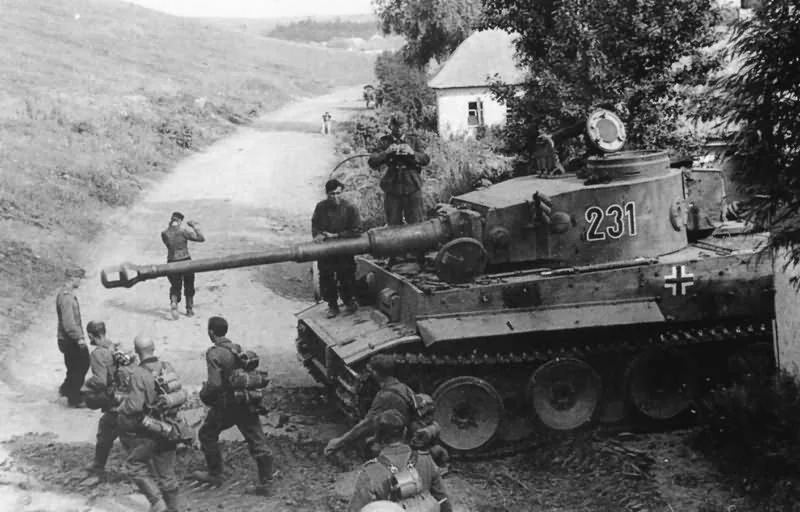
This is Tiger 231. I don’t know the unit it is a part of, but I think it’s probably on the Eastern front during 1942 or early 1943 (It appears an Ausf. H or H1, notice the commander’s cupola).
231 is broken down like so.
The first number means the Panzer company it is a part of. 2nd company, so I regiment of what ever Panzer division it is part of.
The second number shows the platoon it’s part of, so is part of the 3rd Panzer platoon.
The third number is the vehicle number in the platoon. So this would likely be the platoon leader’s vehicle, as it’s the 1st vehicle in the platoon.
We’ll go with a second one for demonstrative purposes.

PzKpfw VI Tiger Ausf E Number 312, unknown which Panzer Division or front (I don’t have documentation for this image either).
This tank’s numbering means its 3rd company, 1st Platoon, 2nd Vehicle.
Now, this is the general rule of thumb, regarding the numbering system, but as you will soon see, the system had drawbacks, especially when it came to making it easy for others to identify the commander’s vehicle with relative ease. This, and the tendency for some Panzer Divisions to do their own variations on things, leads to a number of possible differences one might encounter. I doubt I can cover all of them reasonably at this time, but I’ll touch on a few.
Among others, Wehrmacht units would create fictional company numbers or jumble the order the numbers were to be read in. For instance, the 12th SS Panzer Division ‘Hitler Jugend’ would start their numbering of platoon vehicles at 5. So instead of 211 for ‘2nd Company, 1st Platoon, 1st Vehicle’ it would would be 215 for the first vehicle, then 216 for the second, and so forth. Some would remove the leading letter for Regimental officers (which was R). As an example, R01 could become 001 then 002, etc. The 2nd SS Panzer Division ‘Das Reich’ had their 8th Company comprised of Tigers and thus numbered their vehicles starting with ‘S’ for Schewere (Heavy). So they’d go S11, S12, S13, and so forth. There were also some who used only two numbers and then a large coloured insignia (such as the 505 sPzrAbt who sometimes coloured the knight’s plume and saddle a different colour) with each different colour representing a different company.
All of this, once again, was intended to obfuscate the structure of the unit being fought and deny the enemy the ability to clearly determine which vehicles had officers in them.
Here’s some additional images that clearly show vehicle numbering.

Panzerkampfwagen VI Ausf. B (H) ‘Tiger II’ Nr. 312, somewhere in Europe, probably 1944/early 1945 due to the American GIs in the image. Possibly taken after the Battle of the Bulge, however I lack any documentation for the image.
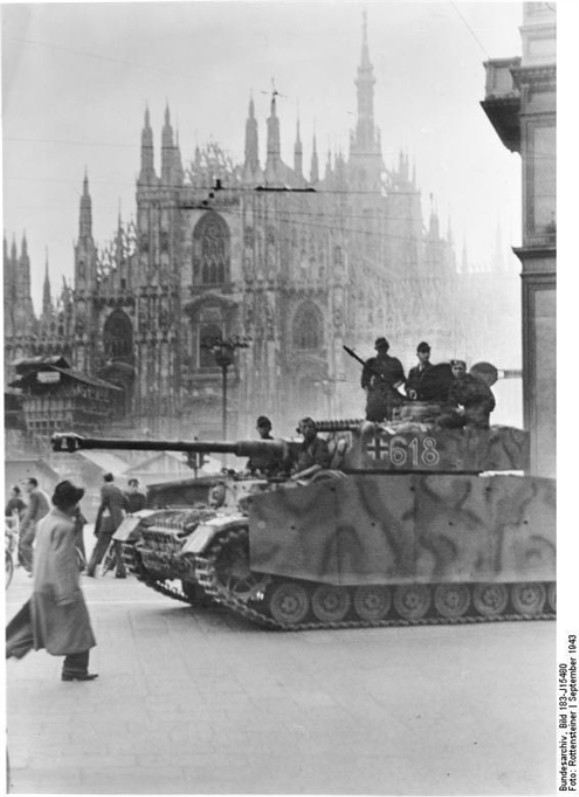
1st SS Panzer Division ‘Liebstandarte Adolf Hitler’ Panzerkampfwagen IV Ausf. H Nr. 618 in Milan, Italy, September 1943. Notice how the numbers are not stenciled, but done by hand. Also, a rather interesting tri-colour pattern camouflage!
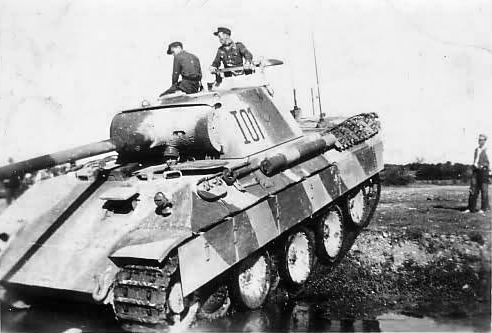
An early model Panzerkampfwagen V ‘Panther’ Ausf. A Number I01. Due to the numbering, this is clearly the 1st Battalion Commander’s vehicle for whatever Panzer Division it is part of. I have no real documentation for the image, but from what can be extrapolated from the image, it’s likely between 1943 – 1944 (due to the vehicle model and camouflage pattern).
And here’s an infographic with some examples of tank Camouflage and numbers, helpful for anyone who wants to recreate tank numbering.
It should be noted that some units prior to the 1944 order mentioned in the info-graphic, used numbers with white outlines. The most common colours for this were black or red numbers with white outlines, though any number of combinations apparently existed during the war (likely due to either individual units wanting to be even more identifiable or the need to paint with what they had on hand/could find). The 1944 order, more than anything, solidified the size, font, and general structure (darker solid colour outlined in a lighter colour) of the vehicle identification number. This is why after the order was issued, you will notice more vehicles follow the white outline with red/black solid numbers and seem to be roughly the same size across all vehicles.
German Tactical Markings
The Wehrmacht used a wide range of tactical markings during the war, and actually changed some partway through. Most were used to identify the type of unit the vehicle was a part of (such as recon, signals, heavy tank battalion, etc) and individual tactical symbols and insignia used to identify the division or regiment the vehicle belonged to. Prior to and during the Battle of Kursk there was a specific system that was used, that utilized configurations of bars and dots to denote the division the vehicle belonged to, which was mostly (but not wholly) abandoned after the battle. Some units, such as the Heavy Tank Battalions and the various SS Panzer Divisions, had very unique and easy to recognize symbols and markings for their vehicles. For the sake of brevity, we’ll try to keep this narrowed down to examples found mostly in Panzer Divisions and Regiments and those related to tanks.
The most basic tactical symbol to indicate a vehicle belonged to a Panzer Division was the symbol of a rhombus (see infographic provided below) that indicated the vehicle belonged to a tank unit (and only tanks seem to have carried it). Early in the war, this was sometimes a metal plate that was attached to the vehicle and could have the 3 number tactical code for the vehicle. Sometimes they were left blank and attached to the side or back of the vehicle or had a single number in them or beside them that indicated the company they belonged to. Later on, the metal plate was replaced by a stenciled or painted in rhombus that could have several different markings that could further indicate what unit or role the AFV served.
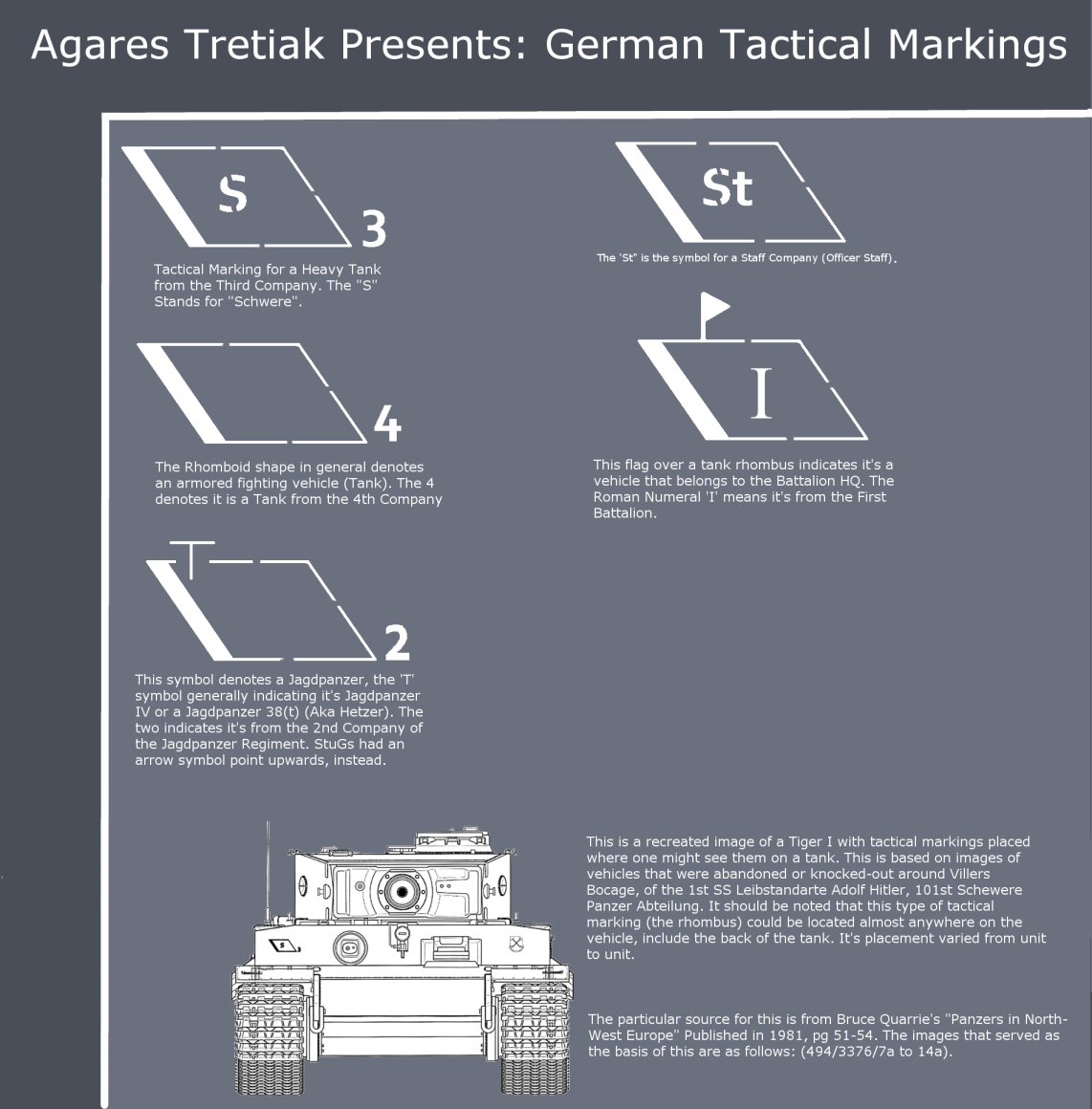
A quick demonstration of the rhombus shaped tactical markings and variations (not exhaustive, however).
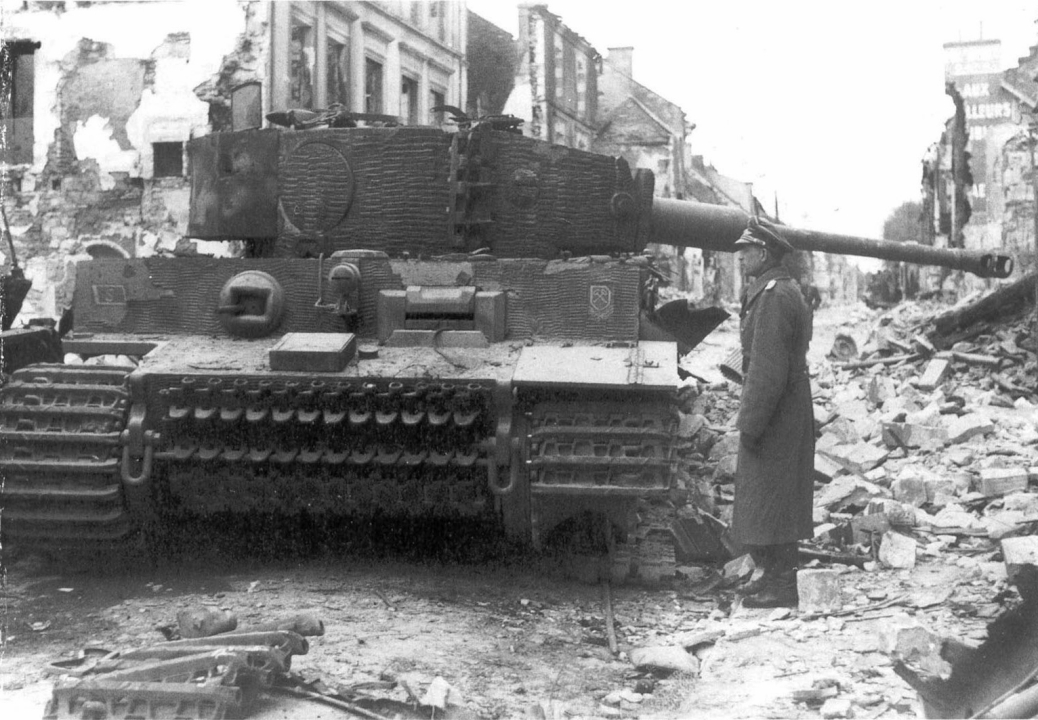
Tiger crippled during fighting in and around Villers Bocage from the 101st Schwere SS Panzer Abteilung (Micheal Wittman’s unit in Normandy). Note the tactical markings on the right and left front of the vehicle and on the turret.
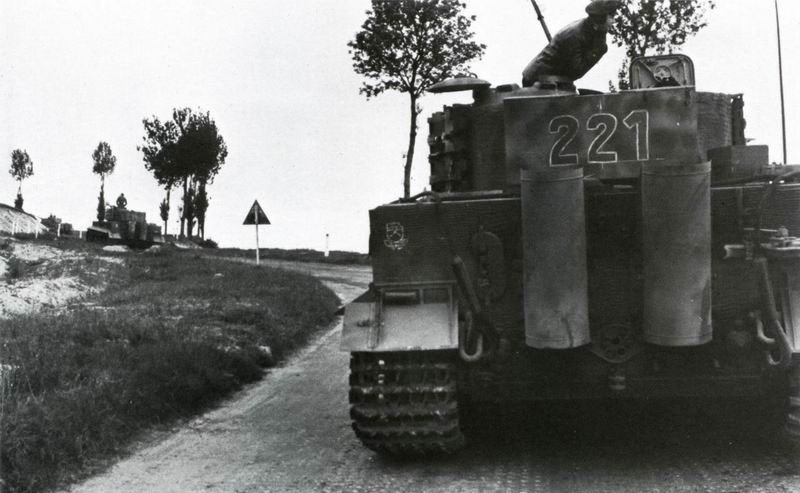
PzKpfw VI ‘Tiger’ I (H) Ausf. E Nr. 221 from the s.SS PzAbt 101. Notice that this vehicle had its tactical marking for the 101st s.SS PzAbt on the back (and potentially on the front).
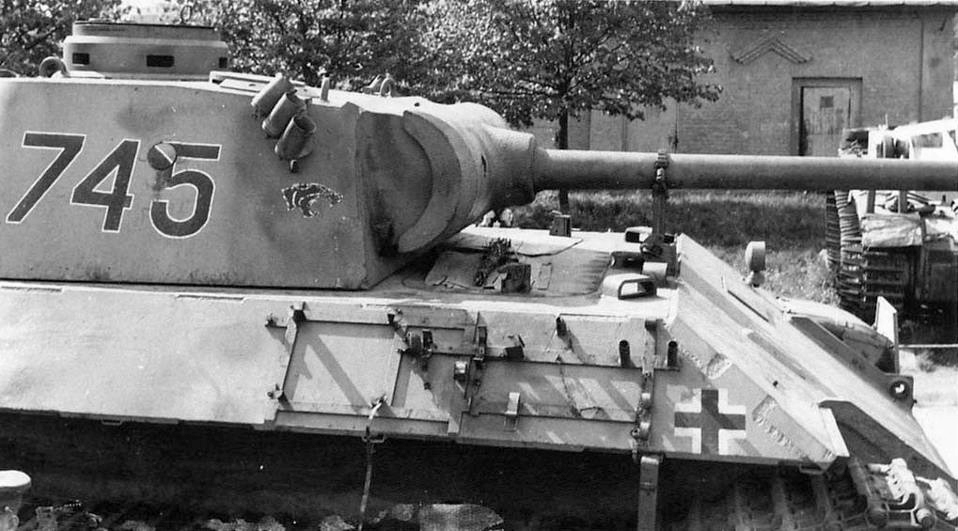
Panther Ausf. D Nr. 745 from the 52nd Panzer Abteilung. The black panther’s head is the symbol of the 7th Company. Panthers and Tiger IIs usually lacked the rhombus marking found on other German AFVs, though this was not always the case.
If one wants a fairly large and accurate list of Panzer Division insignia, Wikipedia actually has a pretty good list of them here: http://commons.wikimedia.org/wiki/Insignia_of_the_Wehrmacht.
In addition to the rhombus, tactical numbers, and unit symbols, the Wehrmacht featured the ubiquitous ‘Balkenkreuz’ (lit. “Bar” or “Beam” Cross, from the shared term “balk”, which is a wooden beam used in reinforcing a structure). It could take a number of forms, from being very narrow and long, to short and squat. Early in the war, the Balkenkreuz was purely white which, as one might image, made excellent aiming points for enemy tank and anti-tank gunners. Their placement on a vehicle was determined first by the type (for instance Tigers mostly had theirs on the sides beneath the turret or on the back of the vehicle) and then by other considerations, like equipment racks, spare track links, etc. There was no real standardization for the Balkenkreuz, though later in the war they closely resembled the form of the ones used on Luftwaffe aircraft.
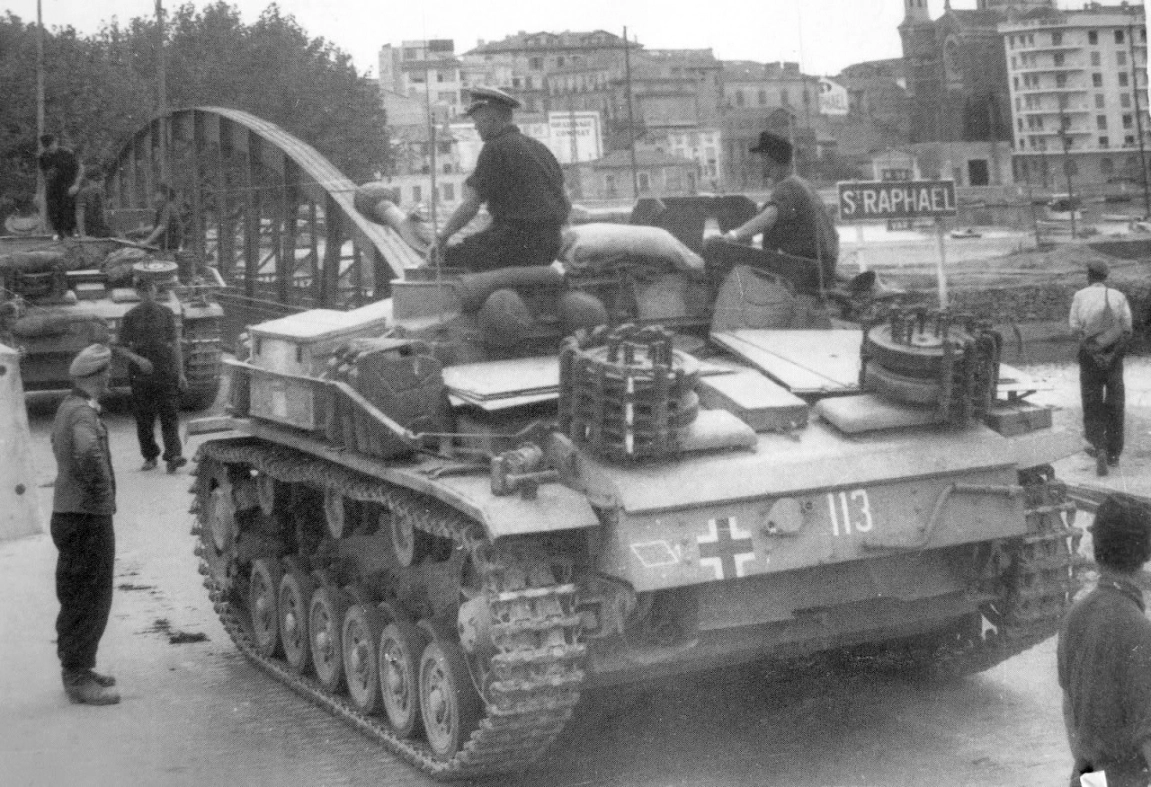
StuG III Ausf. G Nr. 113 with tactical markings on the rear fender. Notice how the Balkenkreuz is located in a different place than the vehicle in front of it.
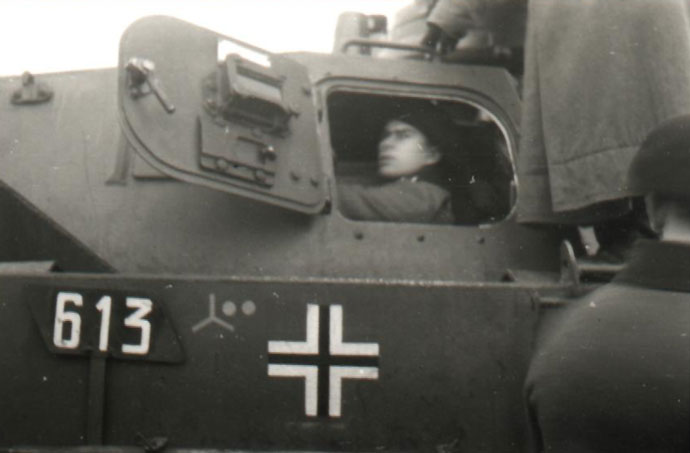
Panzer IV Ausf. (C or D) Nr. 613 from the 6th Panzer Division. Notice how the Tactical symbol (the Rhombus) is a metal plate and that the Balkenkreuz is narrow.

Various Panzer models advancing towards the fighting from Panzer Group von Kliest (hence the large ‘K’ on the vehicles). This feature would also show up as ‘G’ for Guderian and other Panzer Groups (and later, Panzer Armies) would follow suite with their own letter or other symbols as identifiers.
Finally, many Panzer crews would try to provide air identification for friendly aircraft so that they could focus on other units by displaying a swastika on the top portions of their vehicles. Normally, this was done with a rolled up flag that was unfurled when they knew or suspected friendly aircraft were operating near them, which could be rolled up if they came under attack by enemy ground-attack aircraft. Some vehicles also opted to paint it on.
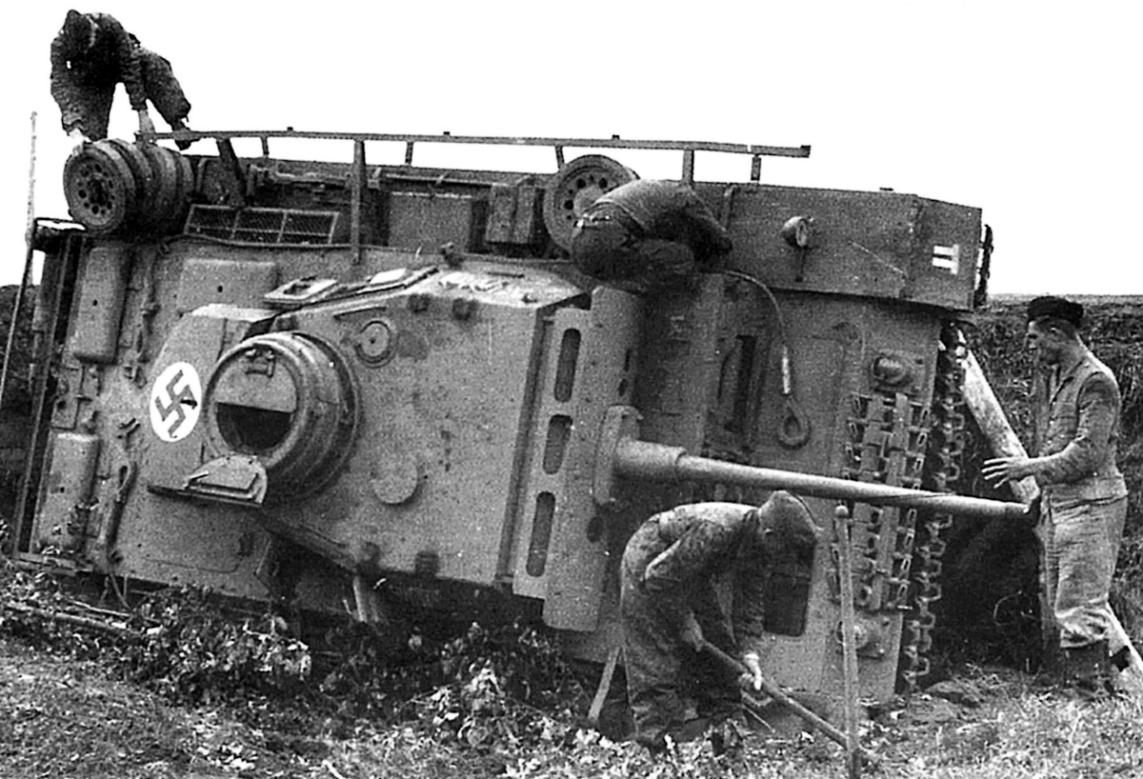
Pzkmpfw III Ausf. J or L which rolled onto its side during combat. Notice the swastika painted on the turret bustle storage bin and the Panzer division tactical marking on the front fender. This particular vehicle belonged to 2nd SS Panzer Division ‘Das Reich’. Note the SS pattern tanker’s uniforms on two of the crew men working on recovering the vehicle.
Hopefully, this article has helped history buffs, modelers, and even game designers with their understanding of the visual characteristics of World War 2 German AFVs. Its a very diverse and complex area of study, due to the sometimes surprising lack of standardization, but one that is fascinating to learn about and it’s my desire and hope that others can appreciate and notice these details in the future, for those who take the time to integrate them into their work.
Next up in my on-going series about tank camouflage and tactical markings will be the United States Army and Marine Corps during World War 2!
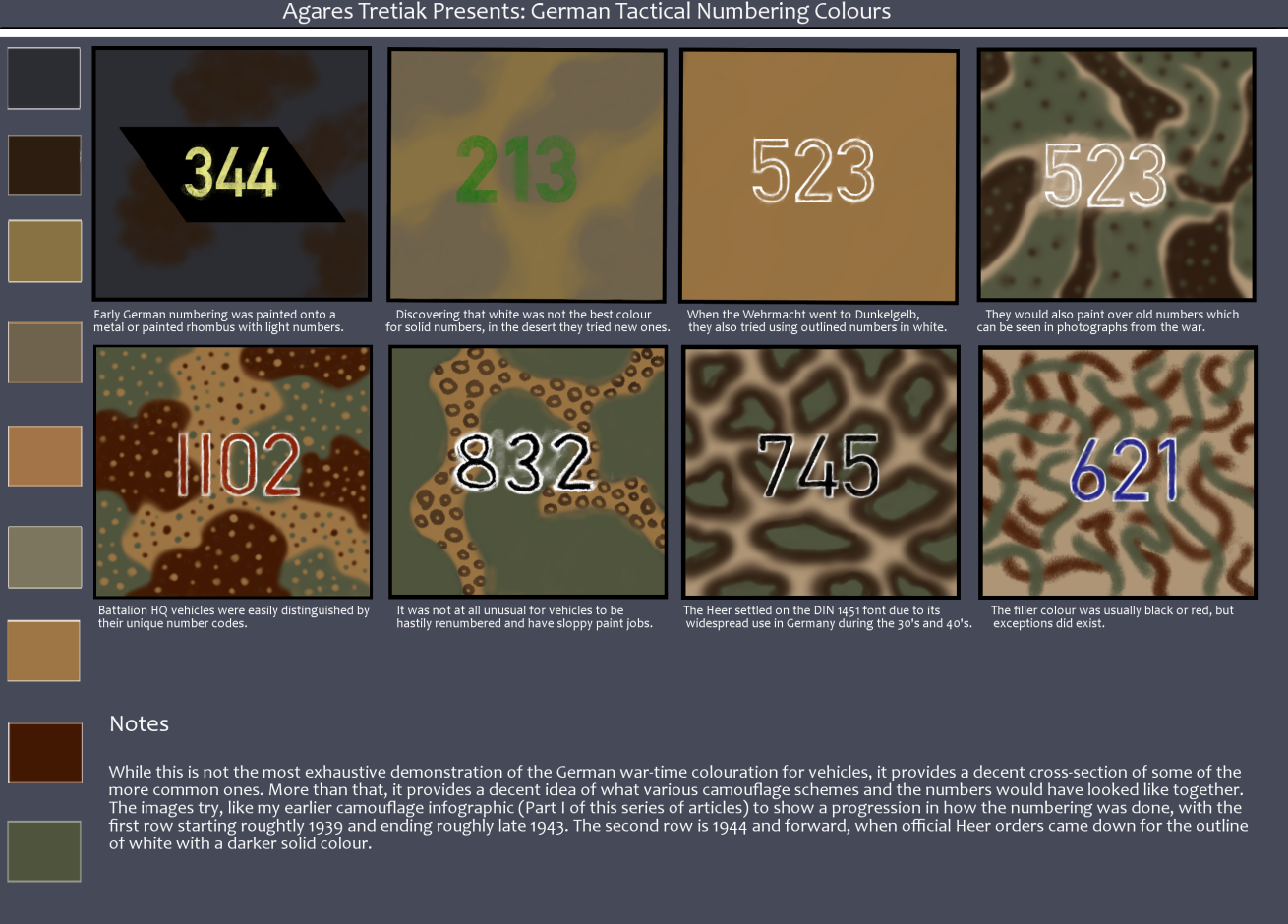
Yeah! Re-blogged it :)
LikeLike
Brilliant where is part one to be had?
LikeLike
It can be found here : https://mistertretiakpresents.wordpress.com/2015/03/09/world-war-2-german-camouflage-and-tactical-markings-part-i/
Glad you enjoyed the article!
LikeLike
Very nice article! Two general questions:
1) Where did you find all of this information? Could you point me towards some references?
2) I am making a model of the battle of Kursk using Tiger tanks from the 2nd SS Panzer Division “Das Reich”. You referenced S11,S12…etc. in the article, however I only have numbered stickers (no letters). Were there other companies of Tiger tanks belonging to the division, that fought in the battle? If so, what turret markings would be appropriate?
Thanks!
LikeLike
I’m glad you enjoyed the article (sorry for the very late reply)!
1) I took reams of notes over a couple of weeks, and searched a wide range of articles, books, and internet sources to compile my response. I sadly did not write down all of these sources, but this website is almost certainly one of them: http://flamesofwar.com/Default.aspx?tabid=110&art_id=287.
2) The numbering system for Das Reich may not have been implemented until after Kursk, as many of the units that partook in that brutal fight were very, very different in the aftermath. I sadly do not have, on the top of my head much information on that subject, so I would also suggest maybe using this book as a visual reference: https://www.amazon.com/Das-Reich-Division-Kursk-Visual/dp/1907446621 for some of the other information about Das Reich at Kursk. If you don’t want to buy it, see if your local library might have it on hand. There’s a lot of technical and historical documentation and research out there, but it can be a bit nebulous and time consuming to gather.
EDIT: I just did a bit more research. Historical images from the battle of Kursk show that the Tigers did indeed use the “S” prefix. Picture: https://s-media-cache-ak0.pinimg.com/originals/5f/b7/b1/5fb7b19675b42b99266127989f187afb.jpg So it seems that your model company supplied inaccurate numbering with the model, which is not… all that uncommon really. They run a business and they probably provided a general set of standard decals off of a template for the three number system that was more common. Just a case of them not doing their research or not caring to to do so.
LikeLike
sir,i like your aricle so much , but where’s the USA tank camouflage and tactical markings in WWII
LikeLike
I apologize for not answering more recently, things have been a bit… hectic for me. I have only a very rough draft of my American tank markings article, as I have been trying to locate some source materials that I can refer directly to.
LikeLike
And sir, i’d like to know the symbol(insignia) of German Divisions(such as 15th Panzer Division ,272volksgrendiers division ,all kinds of divisions not only panzer division ) and all kinds of independent regiments/battalions (such as s.Pz.Abt501/ s.Pz.jg.Abt512 ). Please give me something
LikeLike
The symbols for these units can be easily located via internet searches, wikipedia or other resources, ranging from books to documentation available in most American libraries. Some countries may restrict this information due to banning all iconography of the Nazi regime.
LikeLike
3) Is SS2 das reich division the only one using the letter S as tank tactical number?? or other divison also does?
LikeLike
I believe Das Reich was the only one to do so, to denote its Heavy (Schwere) tank units. However, it is possible it may have been used elsewhere. I know some of the tactical markings that weren’t part of tank formation identification, such as the rhomboid markings, might have utilized an ‘S’ to denote a heavy tank.
LikeLike
I didn’t read in your story what the letter V was for on German tanks. Can you please let me know what it meant.
LikeLike
I’m sorry for the late response, Bob. Could you explain or show a picture that has an example, so I can help figure out what it represents?
LikeLike
I see that German infantry divisions also had division symbols. In the US Army, these were worn on shoulder patches (and still are). Where were they displayed in the Wehrmacht?
LikeLike
Thank you for the question! From what I can gather, like a whole lot of things related to the German military during WW2, it really depends on a couple of factors and the placement could be varied. A lot of the ‘named’ divisions and units had theirs displayed on ribbon tape on the lower sleeve. Where and which sleeve seems to depend on the unit in question. A few with specific symbols would display their division on their lower or upper sleeve, again depending on which unit. It is entirely possible some did not display any at all. You’ll have to forgive me, as I am not really well read on the markings for the Infantry units like I am on tanks and other AFVs.
LikeLike
Excelent site !!!!
LikeLike
hope you can reply me ASAP, i really need it also in a hurry
LikeLike
Sir, i wanna know some tanks only have two numbers or only one , why ?
LikeLike
Cool article, I have a set of decals for some models i have that contain the numbers 200 and 100. What would these vehicles be?
LikeLike
In some tank units, the 200 and 100 would stand for the command vehicles for the 1st and 2nd tank companies. Some units would flip this around. It really depends on the unit.
LikeLike
so if im building a model would it be incorrect to have the 1st ss key on a tiger tank?
LikeLike
No, it would not be incorrect. You should, however, look up examples of 1st SS Tigers to get a good feel for how their markings were applied to the vehicles in question.
LikeLike